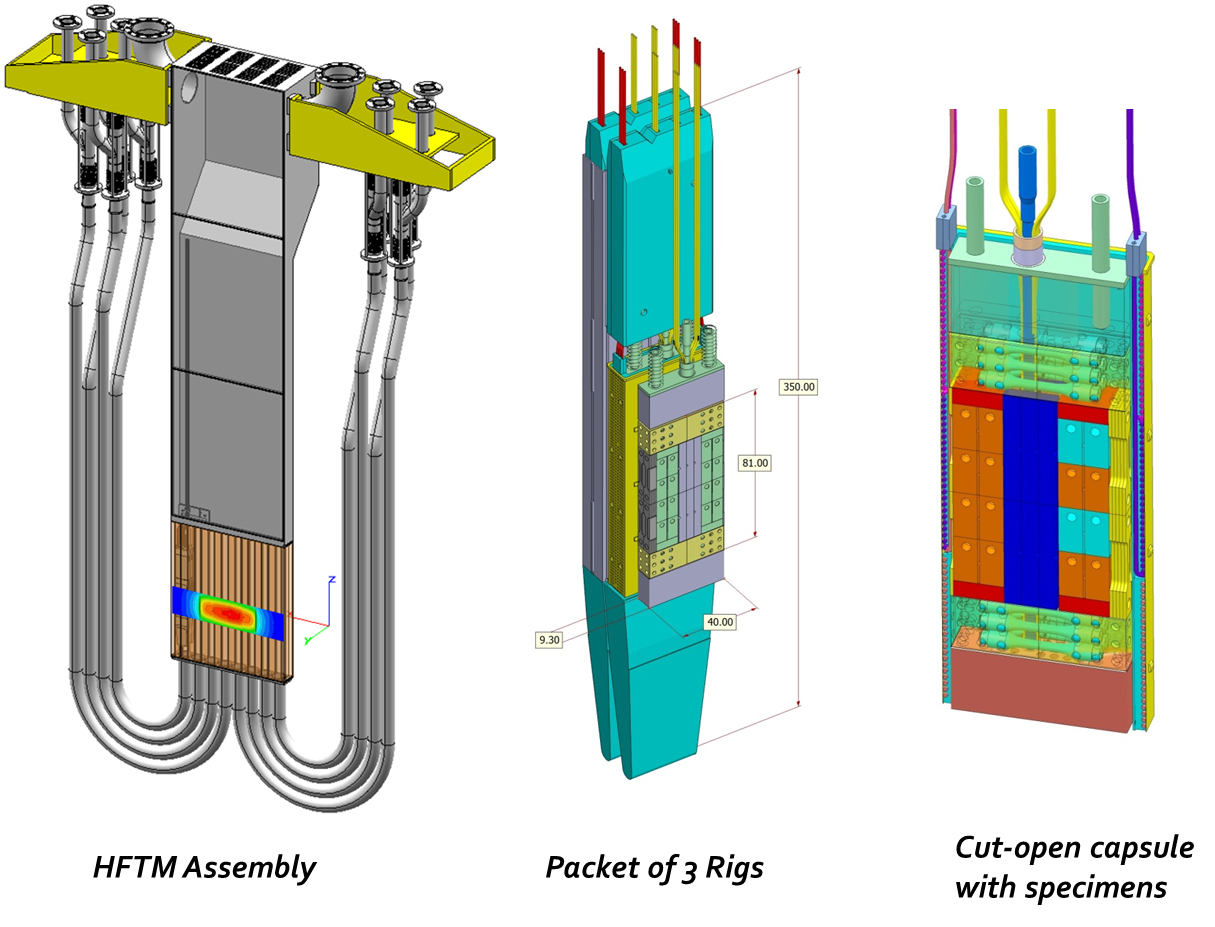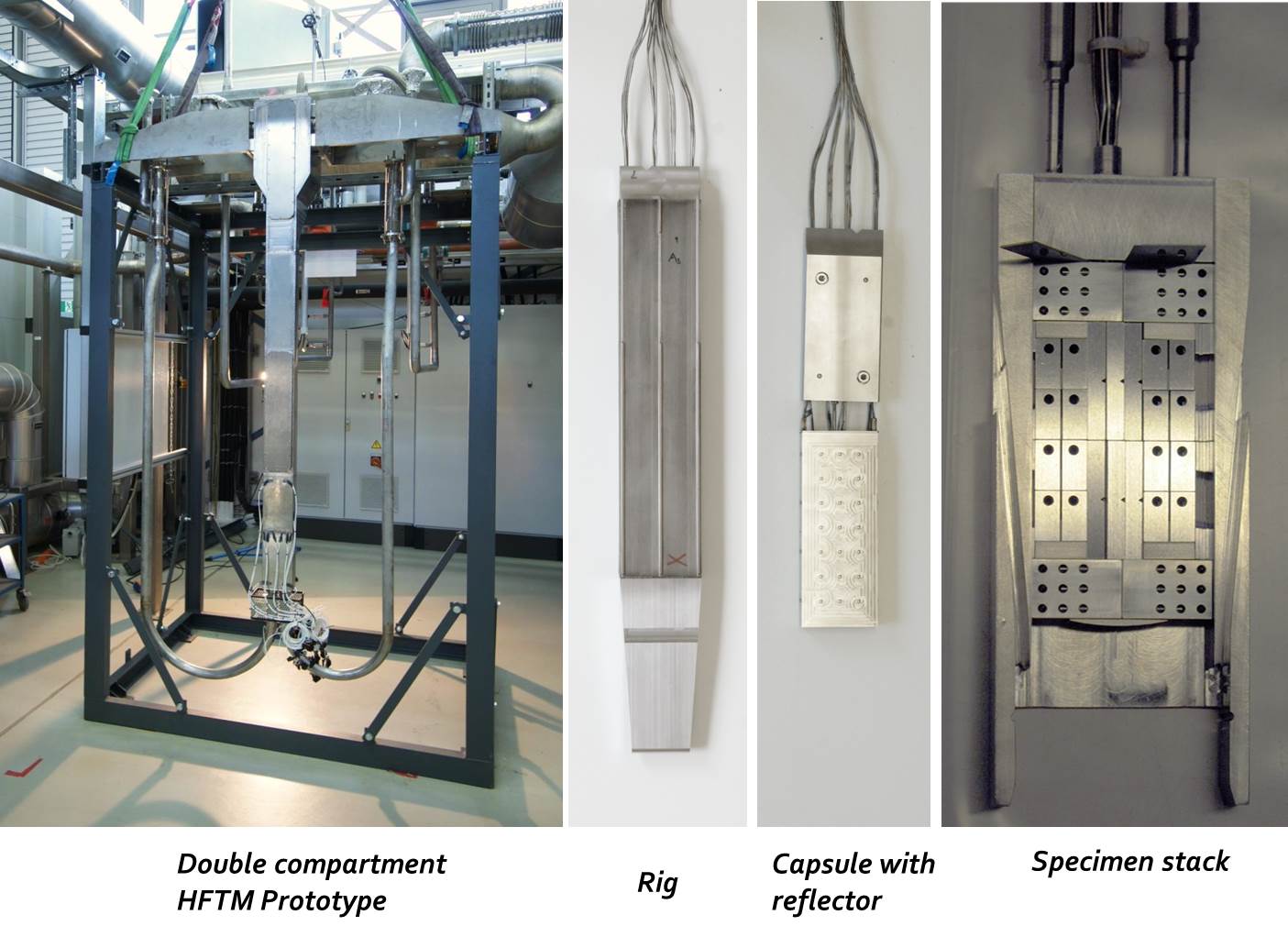The irradiation of small specimens is planned at several blanket-relevant irradiation temperatures and shall accumulate structural damage of up to 150 NRT dpa. The HFTM will allow the irradiation and the temperature control of the specimens by an active cooling system of He gas. The HFTM is mainly dedicated to the research on RAFM steels, to be tested in the temperature range 250-550°C, with an option to provide irradiation up to 650°C. The uncertainty of temperature for 80% of the specimen is demanded to be below +/-3% related to the absolute nominal temperature. Further, it is an aim to cool the specimen from their temperature to below 200°C to freeze the irradiation defects after the irradiation within 15 minutes. The arrangement of the specimens in the HFTM is adapted to the beam footprint of the neutron source, which is 20 cm x 5 cm. The specimen alignment, and the dimensioning of reflectors, must limit the neutron flux gradient to less than 10% of the individual sample gauge volume. In order to transmit the neutron flux with as little as possible losses to the specimens, the HFTM structures need to be thin, and avoid materials with a high neutron absorption cross section. A minimum of 26, but possibly up to 40 specimens per alloy, should be accommodated for a single irradiation position. The structures of the HFTM might be exposed to damage rates of up to 50-55 dpa/fpy but are submitted to stresses.
The HFTM is built from a thin walled container divided into eight compartments, into which three rigs can be placed in each (for a total of 24 rigs). The central four compartments (360 cm³ for specimens) are inside the beam footprint where neutron flux levels are suitable for high quality irradiation experiments. The remaining four out-of-centre compartments are also filled with rigs. The function of these so called companion rigs is mainly to act as lateral neutron reflectors, but also to accommodate instrumentation, like fission chambers for online flux monitoring. In the two compartments located at the lateral ends most distant from the source, the neutron flux amounts to only about 10% of the central positions, but flux gradients are low, and can thus be attractive as additional irradiation space.
The specimens are contained in rectangular irradiation capsules (external dimensions 120 mm x 46.7 mm x 13.4 mm) equipped with electrical heaters, which can partly compensate the spatial distribution as well as temporal fluctuations of the nuclear heat release. In order to homogenize the temperature field, gaps between the specimens are to be filled up with liquid NaK-78 eutectic alloy. The capsules are encased inside irradiation rigs, which incorporate neutron reflectors on the upper and the lower end. In order to guarantee the severe temperature gradient allowed, gaps between encapsulated specimens are filled up with liquid NaK-78 eutectic alloy. The capsules are encased inside irradiation rigs, which incorporate neutron reflectors on the upper and the lower end. A helium gas flows between the capsule surface and the rig functions as the main thermal resistance between the specimen and the heat sink with a maximum gap of 1.35mm depending of the capsule target temperature level (250-650°C). In turn, the irradiation temperature is measured and controlled thanks to various (between 3 and 6) type-K thermocouples located inside the specimen stack. The thermocouple readings will be the input to the control of the capsule’s electric heaters. In the current design, the thermocouples are directly immersed in the NaK of the specimen stack.
The capsules will be tested under irradiation conditions realized in the Belgian BR2 research reactor. This irradiation will provide nuclear heating of approximately 3 W/g as in the HFTM, but obviously considerably lower total doses than anticipated for IFMIF end-of-life can be accumulated in this campaign. Main objectives are the test of the heaters and the capsule temperature control, but also the recovery of the specimens after irradiation under hot cell conditions. Such experience will be most valuable for the planning of the IFMIF hot cells and related logistics and workflow optimization.
The last step of validation consists of the testing of a 1:1 prototype HFTM installed in the HELOKA-LP helium loop facility at KIT, operated under IFMIF design operation conditions, in what regards mass flow (up to 0.120 kg/s), gas pressure (0.3 MPa) gas temperature and electrical heating of the capsules. The test objectives include the verification of the temperature control strategy, assessment of flow induced dynamic loads on the rigs, the attachment structure and the helium pipes, and the definition of operational modes (startup/shutdown, emergency stops, cooldown transients etc.).




